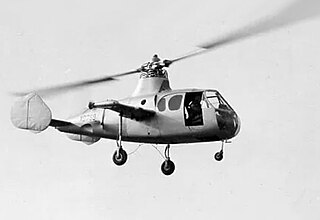
The Focke-Achgelis Fa 223 Drache was a helicopter developed by Germany during World War II. A single 750-kilowatt (1,010 hp) Bramo 323 radial engine powered two three-bladed 11.9-metre (39 ft) rotors mounted on twin booms on either side of the 12.2-metre-long (40 ft) cylindrical fuselage. Although the Fa 223 is noted for being the first helicopter to attain production status, production of the helicopter was hampered by Allied bombing of the factory, and only 20 were built.

The Flettner Fl 282 Kolibri (Hummingbird) is a single-seat intermeshing rotor helicopter, or synchropter, produced by Anton Flettner of Germany. According to Yves Le Bec, the Flettner Fl 282 was the world's first series production helicopter.

The Fairey Jet Gyrodyne is a British experimental compound gyroplane built by the Fairey Aviation Company that incorporated helicopter, gyrodyne and autogyro characteristics. The Jet Gyrodyne was the subject of a Ministry of Supply (MoS) research contract to gather data for the follow-up design, the Rotodyne.

The Bell R-12 was an American 1940s military utility helicopter built by the Bell Helicopter company. The design did not go into full production, but over a dozen prototypes were used for various tests and projects.

The Bölkow Bo 103 was an ultralight experimental helicopter flown in West Germany in 1961. It was designed for reconnaissance and command-control purposes and constructed by Bölkow Entwicklungen KG as part of a research order by the German Federal Ministry of Defense.

The Gyrodyne RON Rotorcycle was a tiny, single-seat helicopter designed under contract for the United States Navy. in the mid-1950s. It later was redesigned for a U.S. Marine Corps requirement for a small personal helicopter that would fulfill an array of roles, including observation, liaison, small unit tactical maneuvers, and which could be dropped to downed airmen behind enemy lines to facilitate their escape.

The Sikorsky S-52 is a utility helicopter developed by Sikorsky Aircraft in the late 1940s. It was used by the U.S. Navy, Marine Corps, and Coast Guard. The S-52 was the first US helicopter with all-metal rotor blades. Initially a two-seater, it was developed into the four-seat S-52-2 and S-52-3. It was designated HO5S-1 by the U.S. Navy and Marine Corps, HO5S-1G by the Coast Guard, and YH-18A by the U.S. Army, and was used extensively by civil operators after being retired by the military.

The Doblhoff/WNF 342 was an early experimental tip jet helicopter designed and produced by Wiener-Neustädter Flugzeugwerke. It was the first helicopter to take off and land using tip jets to drive the rotor.

The Wallis WA-116 Agile is a British autogyro developed in the early 1960s by former Royal Air Force Wing Commander Ken Wallis. The aircraft was produced in a number of variants, one of which, nicknamed Little Nellie, was flown in the 1967 James Bond film You Only Live Twice. Little Nellie and another sixteen of his autogyros are currently on static display with his second cousin at Wallis & Son Land Rover showrooms in Barton, Cambs.
The Airmaster H2-B1 is a British two-seat ultralight helicopter built by Airmaster Helicopters of Camberley, Surrey.

The Sack AS-6 was a German prototype circular-winged aircraft built privately during the Second World War.
The Bauer BAD-12 Gyrotrainer is a Czech autogyro, designed and produced by Bauer Avion of Prague. The aircraft is supplied as a complete ready-to-fly-aircraft.
The Midwest Hornet is an American autogyro that was designed by Don Shoebridge and made available by Midwest Engineering & Design in the form of free plans for amateur construction.

The Rotortec Cloud Dancer II is a German autogyro, designed by Jochen Steinbeck and produced by Rotortec of Görisried, Allgäu. The aircraft was first shown at AERO Friedrichshafen in 2009 and is supplied as a complete ready-to-fly-aircraft.
The Nord 1700 Norélic or SNCAN N.1700 Norélic was a French helicopter with several novel control features. Only one prototype was built, though it was intended to lead to series production.
The Rotorwing-Aero 3D-RV is an American autogyro that was designed by Monte Hoskins and produced by Rotorwing-Aero of Salt Lake City, Utah, introduced in 1989. Now out of production, when it was available the aircraft was supplied in the form of plans for amateur construction.

The Wombat Gyrocopters Wombat, sometimes called a Julian Wombat, is a British autogyro that was designed by Chris Julian and produced by Wombat Gyrocopters of St Columb, Cornwall, introduced in 1991. Now out of production, when it was available the aircraft was supplied as a kit for amateur construction.
The GoFly Gotar is a French autogyro that was designed by and was under development by GoFly Aeronatique of Boves, Somme, introduced in 2013. The aircraft was intended to be supplied to customers complete and ready-to-fly.
The Trixy Trixformer is an Austrian roadable aircraft autogyro/electric motorcycle designed and produced by Trixy Aviation Products of Dornbirn, introduced in 2014. The vehicle is supplied complete and ready-to-fly.
The Trixy Liberty is an Austrian autogyro designed and produced by Trixy Aviation Products of Dornbirn. The aircraft is supplied complete and ready-to-fly.













